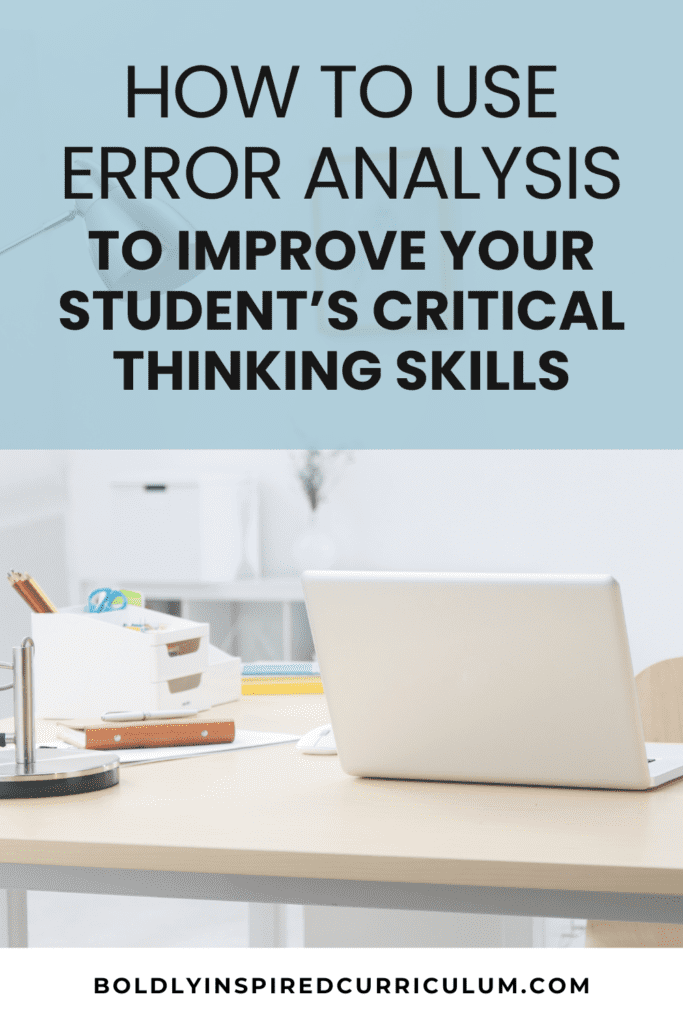I get roasted by my high school students way more often than I’d like to admit. There is one time it doesn’t bother me too much: when they are correcting my math mistakes. This shows me that they’re actually using their mathematical reasoning skills and analyzing the work that we are doing.
Instead of only focusing on getting the right answer, they dig deeper into the reasoning behind the errors. This process helps develop problem-solving skills and an in-depth understanding of mathematical concepts.
In this blog post, we will explore how you can use error analysis to improve your high school math students’ growth mindset and problem-solving skills.
Table of Contents
ToggleLooking for different ways to help your students develop their mathematical reasoning? Check out these blog posts ↓

Where to start:
By the time your students get to high school, there is a good chance that they are afraid of making mistakes. At some point they learned that it wasn’t okay to get the wrong answer and the only reason to try in math class was the get a good grade.
Somewhere along the way we lost the practice of problem solving and working through the struggle. That’s where error analysis can help your students develop their mathematical reasoning skills.
Before your students are fully comfortable with investigating their own mistakes, they will need a bit of practice. This all starts with normalizing mistakes in your own classroom. That means letting your students call you out when you make an error and modeling a positive reaction.
How you react makes a huge difference in how your students feel in your classroom. Errors don’t need to be a big deal. In fact, they should be celebrated.
Ways to integrate error analysis in your classroom
Exit tickets
This is a quick and simple way to add open-ended, critical thinking questions to your routines. The more that your students are able to practice this type of problem the more comfortable they will get with the idea of mistakes helping them learn. Ultimately, this will lead to an overall increase in their confidence in math class.
Try a free sample of these grab-and-go writing prompts that work perfectly for exit tickets

Stations
Create 4-5 stations with different error analysis problems for your students to complete in groups. They can use whiteboards to show their work and discuss different strategies. Working through problems verbally and with other people can help your students gain different perspectives.
I’ve noticed that my students often struggle with finding errors when first starting out because they are used to problems being done correctly. These activities give them the opportunity to unlock their critical thinking brains.
Quiz Corrections
Try giving your students minimal feedback on a quiz and having them use their resources to find their errors and correct them.
Error analysis encourages self-reflection, a valuable skill in both mathematics and life in general. When students review their mistakes, they become more aware of their thought processes and habits.
An added bonus for this strategy is the fact that it is personalized to each student. They will be able to pick out exactly what they don’t understand and work towards strengthening that skill.
Whole group using student work samples
I love using fake student work samples from common errors that I see on assignments to help my students analyze work.
This is also a great way for students learn about critiquing and giving effective feedback. With these activities, I recommend stressing the importance of giving detailed explanations to help the “student” understand where they went wrong.
You can model this like you are correcting a student’s work on a test or quiz, then give your students a chance to practice their mathematical reasoning skills and try it on their own. This will lead to some great discussions about the concept.
Assessments
Finally, you can put it all together by adding error analysis questions to any assessment. You’ll be able to see if your students have full mastery of a concept with this type of critical thinking questions.
Error analysis is a powerful tool that can change the way high school students approach math. It promotes mathematical reasoning, a growth mindset, self-reflection, and collaboration.
This not only helps students excel in math class, but also teaches them skills that will be invaluable throughout their academic and professional careers.
Teachers who incorporate error analysis into their math instruction are allowing their students to develop a deeper understanding of math and the tools they need for success in the future.
